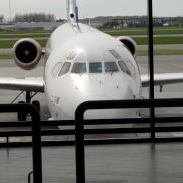Travel News
New Study Links High U.S Flight Cancellations to Tarmac Delay Rule
U.S airlines are recording a 10 year high in the number of canceled flights, citing huge storms like Hurricane Irene and other weather-related incidents as the reason.
United Continental, Delta Airlines and many of the other large airlines have cancelled 104,000 flights so far in 2011–2.36 percent of all scheduled flights. According to the U.S. Bureau of Transportation Statistics, if it continues at this rate, the number of cancelled flights will be the highest it has been since 2001.
Although reports link the delay to weather problems, a new study released from the Government Accountability Office (GAO) cites the tarmac delay rules implemented by the Department of Transportation (DOT) as a leading factor.
According to the study, those regulations have caused a spike in canceled flights and made airlines more prone to canceling flights in order to avoid delays and the hefty fines associated with the delays.
In April 2010, in order to combat lengthy tarmac delays, the DOT introduced passenger protection regulations, including the three-hour tarmac delay rule. According to the new rules, U.S. airlines must offer passengers the option to get off a plane stuck on the tarmac or they face hefty fines. These rules have proven to be extremely effective as lengthy ground delays have almost ceased to exist.
 According to the study, the number of planes caught up in tarmac delays went from 693 to 20 in the 12 months following the April 2010 legislation. Although this is good news, the GAO links this to more flight cancellation, which, in fact, can lead to longer overall passenger travel times. The GAO tested a variety of factors causing flight cancellations from May to September of 2009 (before the new rules) and May to September 2010 (after the new rules) and found there was an increased likelihood of cancellation in 2010.
According to the study, the number of planes caught up in tarmac delays went from 693 to 20 in the 12 months following the April 2010 legislation. Although this is good news, the GAO links this to more flight cancellation, which, in fact, can lead to longer overall passenger travel times. The GAO tested a variety of factors causing flight cancellations from May to September of 2009 (before the new rules) and May to September 2010 (after the new rules) and found there was an increased likelihood of cancellation in 2010.
During the testing period, airlines were 24 percent more likely to cancel flights before they even left the gate in 2010 than in 2009. If the plane reached the tarmac and was forced to wait for 121-180 minutes, the likelihood of canceling the flight rose to more than 3 times as likely.
To combat this increasing problem, the GAO recommends that the Department of Transportation “assess the full range of the tarmac delay rule’s cost and benefits and, if warranted, refine the rule’s requirement and implementation.”
The DOT has not commented on this particular recommendation, but has said that it will look into the effects of the tarmac delay rule.
By Alyssa Caverley
Related links: Government Accountability Office: Airline Passenger Protections, Bloomberg
Related links on PeterGreenberg.com












